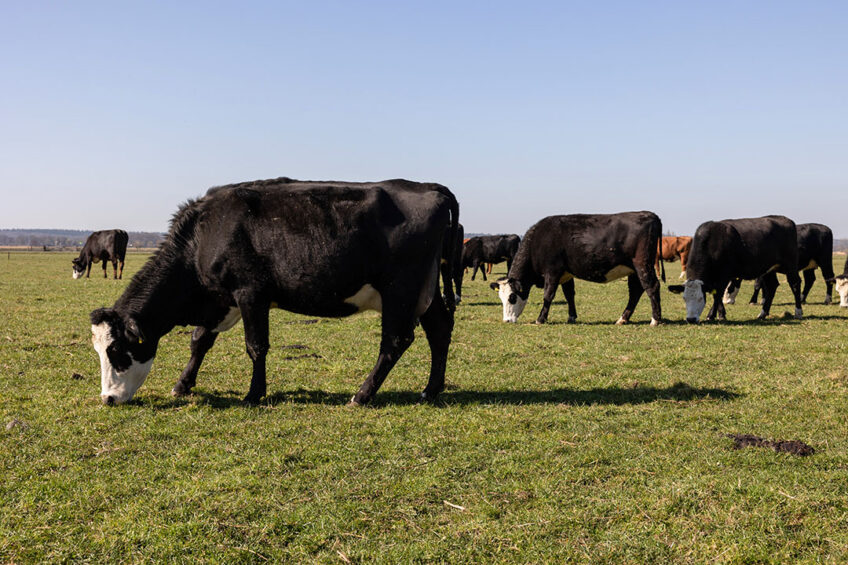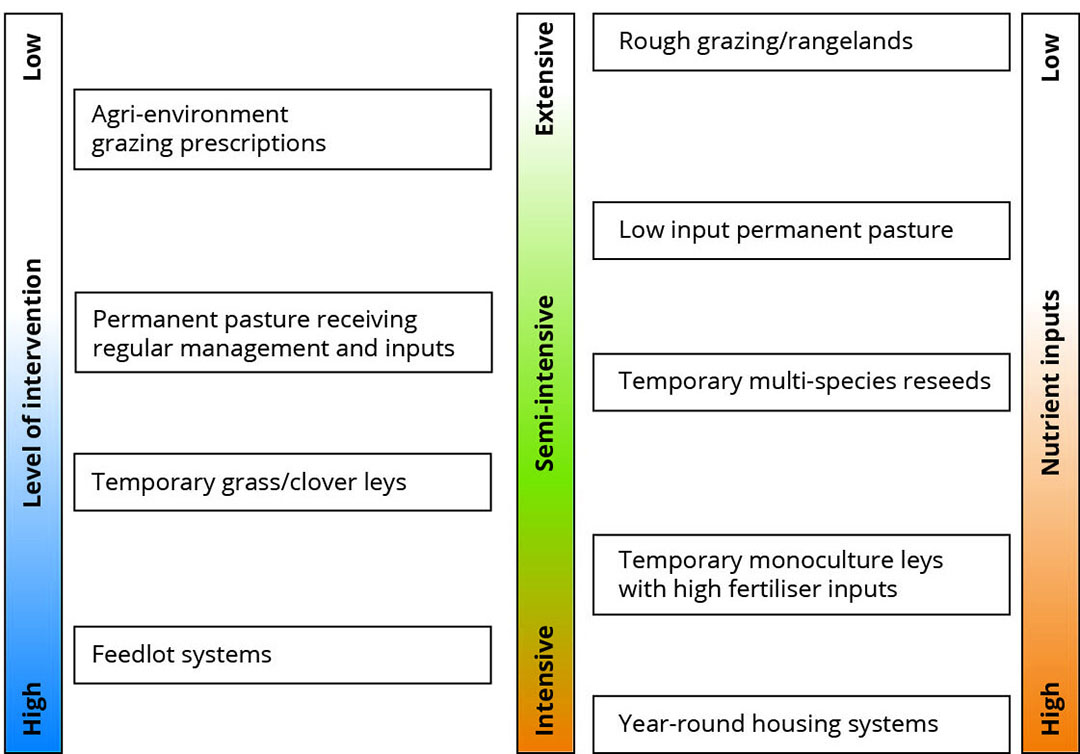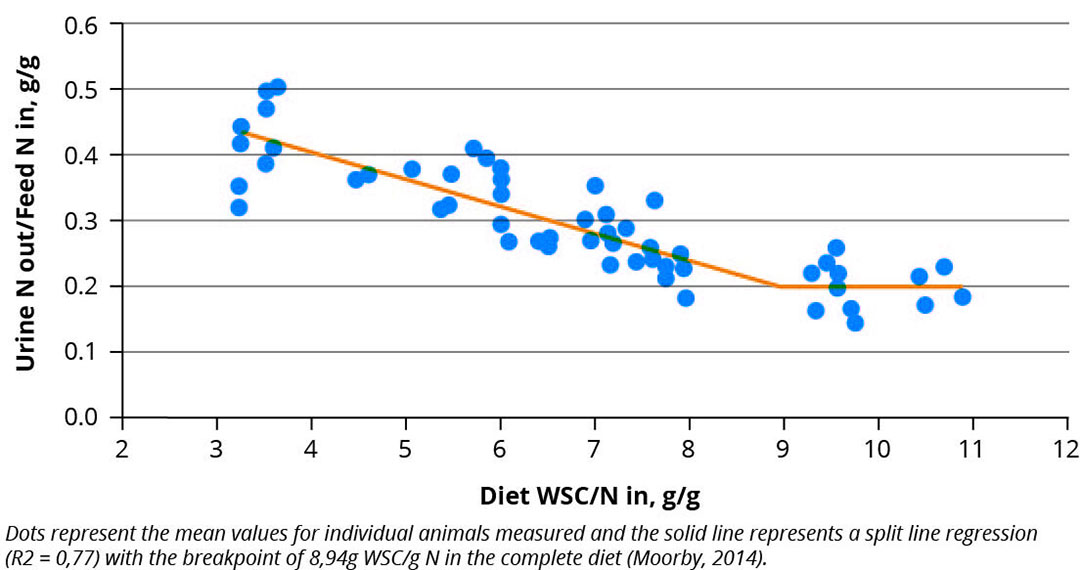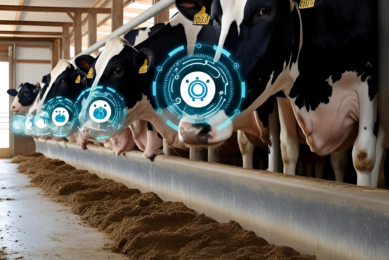New feeds and feeding systems for forage-fed ruminant livestock

There is growing public concern about the contribution of livestock production to global environmental issues. This article focuses on potential new feed and feeding systems intended to make forage-fed ruminant livestock systems more sustainable.
With a growing global human population and increasing global demand for meat and milk as societies become more affluent, the direct and indirect contribution that livestock production makes to greenhouse gas (GHG) and other pollutant emissions are well understood and have become the focus of considerable policy and media attention, as well as public concern.
Despite these concerns, ruminant livestock and their products will continue to play a significant role in providing nutrient-rich food for many people. They also offer a means by which plants that cannot be digested by humans, e.g. grass, can be converted into human-edible protein and so provide a means of producing food in areas unsuitable for cropping due to poor soil or climatic conditions.
New feeds & feeding systems
The development of new feeds and new livestock feeding systems has been an ongoing process for centuries. While many of the challenges faced by society in the past continue today (e.g. food security, rural depopulation, poor financial sustainability of upland farming), plant breeding in general remains tasked with addressing global environmental crises, including climate change and loss of biodiversity. This article focuses on the potential next steps for forage-fed ruminant livestock systems.
Designing efficient diets
For this purpose we have assumed that forage, likely grass-based ruminant production systems will form the main dietary component. However, we also recognise that there is a continuum of production types (Figure 1) and define intensive livestock systems as those in which animals are fed a diet that is designed to be used as efficiently as possible.
Figure 1 – Mapping of the central components of alternative
ruminant livestock systems to definitions of intensive,
semi-intensive and extensive production, where temporary leys are <5 years old and permanent pastures are >5 years old.

Semi-intensive systems include those in which diet choices are less limited but still designed to support efficient production. These include grazing leys sown with specific forage species and cultivars that are managed to optimise the efficiency of use of feed resources, or areas of longer-term pastures that are managed to improve their nutritional characteristics using applications of fertiliser and cutting regimes.
Measuring animal performance
The simplest definitions of livestock production efficiency, such as feed conversion efficiency (e.g. kg feed in/kg product out) or individual animal efficiencies of use of energy (e.g. MJ product energy produced/MJ feed energy consumed) or nitrogen (N), show that ruminant livestock (beef and dairy cattle, sheep and goats) are relatively inefficient compared to monogastrics (pigs and poultry).
However, to judge ruminant livestock only by these metrics ignores the abilities of these animals to use human-inedible feeds to produce highly nutritious food for people. When only minimal amounts of human-edible protein are included in animal feeds, ruminant livestock can be highly efficient in converting human-inedible feed to human-edible meat and milk, particularly when offered as forage-based diets.
More recently, new metrics of efficiency, based on losses from the system rather than production gains, have become commonly used. Livestock are responsible for approximately 14.5% (in CO2 equivalents (CO2-eq)) of local anthropogenic GHG emissions, about 44% of which is methane. Ruminant livestock produce significant amounts of methane as a by-product of microbial fermentation and measures of GHG emission intensities (kg CO2-eq/kg product output) show these are also consistently higher for ruminants than monogastrics.
Nitrogen emissions
Livestock production also contributes directly and indirectly to nitrous oxide emissions from manure and slurry management, through the use of N fertilisers and the deposition of N in urine patches. N excreted from livestock also contributes significantly to undesirable nitrate leaching to groundwater and atmospheric ammonia emissions. Despite being relatively efficient at extracting energy from sources that monogastric animals cannot use effectively (i.e. plant fibres), ruminant livestock are relatively inefficient at using dietary protein for productive purposes (gN in product/gN intake). Dairy cows are generally intensively managed, yet approximately three quarters of the N they consume is excreted rather than being converted into milk protein.
Use of technologies
However, a wide range of individual animal efficiencies (approximately 14-45%) highlights the potential for improving the capture of feed protein into milk with an appropriate and accurately balanced animal diet. The use of technologies, such as mid-infrared spectroscopy, could be applied to monitor individual animal production efficiency and health by measuring milk composition and dynamically altering nutrient intake through the provision of different feeds to tailor protein and energy supplies to the requirements of that particular animal, for example.
Amino acid balanced diets
The ability to ferment fibrous materials to extract energy-yielding nutrients (in particular, volatile fatty acids) is a key benefit of ruminant livestock compared to monogastrics. Much of the protein that ruminants digest in the small intestine is microbial protein formed in the rumen, the production of which depends on the efficiency of fermentation. This complicates the precision with which ruminant livestock can be fed an appropriate balance of amino acids compared to pigs and poultry. The supply and balance of amino acids that are absorbed from the gut and made available to productive tissues (i.e. muscles and mammary glands) are what ultimately determine the efficiency of growth and milk production. Researchers have suggested that the greatest scope for improving the efficiency of dietary protein use in cattle is by ensuring optimum supplies of rumen degradable N, along with optimising the efficiency of N use for the synthesis of protein.
Sustainable livestock production
Improvements in milk production by high-yielding dairy cows can be achieved by supplying protein sources that are not completely degraded in the rumen, thus by-passing the processes of feed N being incorporated into microbial protein. Many feeds are by-products of human food (and fuel) production, such as dried distillers’ grains and rapeseed meal, while others, including soya beans, may be grown specifically for livestock feed. However, reducing the use of soya grown and used as an animal feed is a key objective to increase the sustainability of livestock production, which will require both the development of replacement protein sources and a reduction in the amount of protein fed to livestock.
Measuring system performance
The process of lowering the emission intensity of ruminant products through higher quality diets can partly be attributed to changes in rumen fermentation, if a better quality diet can be achieved by providing starchy feeds (cereal grains) as a replacement for high-fibre feeds. However, the ability to use high-fibre feeds, many of which are produced as a result of the production of human food or which can be grown in places where human foods do not grow well, has always made ruminant livestock a valuable component of agriculture.
Although reducing cattle numbers to decrease their use of human-edible foods has been calculated as having the potential to significantly reduce agricultural GHG emissions, particularly methane emissions, this analysis did not include permanent pastures and appeared to treat all concentrate feeds as equally negative in terms of food energy use by livestock.
Use of agricultural land
While it is true that some land currently used for livestock production could be used for human food production, a significant proportion of agricultural land in parts of the United Kingdom (UK) and other European countries has been classified as less favourable due to constraints relating to abiotic factors, such as soil type, topology and climate.
Life cycle assessment
Differences in the way livestock are fed (e.g. in the United States, where grazed grass is used primarily for beef production, with relatively little used for other livestock types compared to northwest Europe, where grazed grass is used more widely for dairy cows), mean that measures of system efficiency can also differ widely depending on the metrics used to judge this. Life cycle assessment (LCA) is an approach that enables more holistic and objective comparisons between different systems, allowing trade-offs and downstream effects and impacts to be investigated.
Decrease in beef production from dairy herd
Researchers have calculated that the intensification of dairy production in the UK could increase the carbon footprint of milk production if beef production from the dairy herd decreases, as might happen if sexed semen is used to breed only replacement heifers, indicating that the wider implications and trade-offs of changing production systems also need to be considered. Similarly, an initial LCA of milk production in Costa Rica showed that specialist dairy farms compared to dual-purpose farms producing both milk and beef, produce milk with the lowest environmental footprint when the production system is considered from birth to farm gate. However, expanding the system boundary showed that dual-purpose dairy-beef farms had the lowest emission of GHG to produce 1kg of milk and 100g beef.
Impact of annual crops
Another reason the carbon footprint of UK milk production may increase is through a move to annual crops, such as maize silage. Perennial crops, such as permanent pasture, have lower cultivation requirements once established. Researchers used LCA methods to show that choice of grazing system coupled with efficient manure management, could reduce the environmental impact of milk production in the UK significantly, achieving reductions of up 22% and 40% in eutrophication and acidification potentials, respectively.
Lack of robust data
For housed animals, several manure management options are available to mitigate the emission of pollutants, but these can be expensive to implement and are not as useful for grazing livestock. In comparison, careful choice of grazing materials offers a relatively quick and cheap way of improving the efficiency of livestock production. However, a lack of robust data, especially for calculating the carbon footprints of agricultural products, hampers the ability to identify the best pollution mitigation options.
Improving nutrient use efficiency
Reducing the use of unsustainably grown feed commodities, such as soya and palm oil, is another a key objective for improving the sustainability of livestock production. However, for this to be achieved alternative feeds need to be found to partially or wholly replace these valuable dietary ingredients and prevent the land use change that can occur to grow them, as global livestock production continues to increase. A study highlighted the role of forage plant breeding to produce more home-grown feeds. A key component of fresh grasses is the water-soluble carbohydrate (WSC) fraction. Although increasing the dietary concentration of WSC through the use of certain perennial ryegrass (Lolium perenne) varieties has led to improvements in milk yield from dairy cows, an arguably more important finding is the reduction in apparent N excretion in urine from cows when they are fed a high-WSC ryegrass-based diet, likely as a result of increasing the efficiency of rumen N use in both fresh and ensiled forages.
Analysis of data collected from whole-body N partitioning experiments with dairy cows fed fresh grass-based diets has shown that excretion of N in urine, expressed as a proportion of feed N intake, is minimised when the whole diet ratio of WSC to N is greater than approximately 9 g/g (Figure 2). Below this value, there is a negative relationship between the dietary WSC to N ratio and apparent excretion of feed N in urine. Increasing feed WSC above this value gives no further reduction in urine N excretion.
Figure 2 – Relationship between diet ratio of water-soluble
carbohydrate (WSC) and nitrogen (N) concentrations and the
proportion of feed N intake excreted in urine in dairy cows fed
fresh ryegrass-based diets.

Another way of reducing N pollution is to reduce N inputs, although this must be done in ways that allow productivity to be maintained. In grazing systems N inputs are often crucial to maintaining pasture productivity (although the value of clovers and other legumes in fixing atmospheric N is increasingly recognised). However, researchers highlighted the negative relationship between grass WSC and CP concentrations – as more N fertiliser is applied, grass CP concentrations increase and WSC concentrations decrease. Thus, although there is a strong correlation between N fertiliser application and grass N concentration, there is relatively little effect of grass N fertiliser applications on the supply of usable protein to the small intestine.
Impact of leguminous forages
Leguminous forages offer significant sustainability benefits for forage-based livestock systems, reducing the requirement for synthetic fertiliser input and improving ruminant livestock productivity. However, their high N, but low WSC, concentrations typically lead to relatively low rates of N use efficiency unless combined with feed ingredients that help improve N use efficiency, such as grasses bred for elevated concentrations of WSC. Some legumes contain secondary compounds that improve N use efficiency by slowing the rate of proteolysis. Red clover (Trifolium pratense) contains the enzyme complex polyphenol oxidase which has been shown to reduce protein degradation in the silo, as well as the rumen. Polyphenol oxidase catalyses the formation of quinones in fresh material which binds to proteins, thereby reducing protease and lipase activity. Reducing or slowing the rate of proteolysis of forage can increase the efficiency of feed protein use for productive purposes.
Alternative feed and feeding systems
Highly productive ruminant livestock on forage-based diets require additional supplementation to perform to their genetic potential. A large proportion of concentrate ingredients may comprise by-products of human food production, such as oil seed meals, straws, and spent brewers’ and distillers’ grains, the use of which as valuable livestock feeds avoids the need for alternative methods of disposal such as landfill or composting. However, cereals and other ingredients, such as soya beans are frequently used to improve dietary energy supply and protein or amino acid balance. To reduce the livestock industry’s reliance on the use of feeds that are grown specially as livestock feed, alternative feeds need to be identified and developed.
The search for more efficient livestock systems has also led to interest in less conventional feedstuffs. Macroalgae (seaweeds) have been used to feed livestock for many centuries, either by direct grazing in coastal areas or by collection and drying for later feeding. The nutritional value for ruminant livestock varies considerably depending on the type (red, brown or green) and species of seaweed, and seasonal changes. The mineral content of various species, in particular, makes them a useful supplement.
As valuable sources of protein, fatty acids and minerals, microalgae of various types and species also offer strong potential as livestock feed supplements. Their composition can vary depending on cultivation conditions, however, production methods and costs currently limit their widespread use in livestock diets. Nevertheless, there is growing interest in the use of some seaweeds to reduce methane emissions from livestock.
Another novel feedstuff currently receiving research and mainstream media attention is insects. Despite the high nutritional value of many insect types, there are a number of barriers to be overcome in many countries before there is sufficient cultural acceptance for their direct consumption by humans. However, using insects as a protein source for livestock is likely to be more favourably received by consumers.
A particular area where alternative feeds could play an important future role is in the supply of amino acids. Soya beans and soya bean meal are used extensively in livestock diets because of their high protein concentration, useful amino acid profile, good digestibility and low fibre concentration. Alternatives such as peas, which can be grown in places where soya cannot (such as in the UK), have a similar amino acid profile to soya (Figure 3) and offer a more sustainable home-grown protein source.
Figure 3 – Mean amino acid profiles of CPs (g/g total amino acids) from insects (Rumpold and Schlüter, 2013a), macroalgae (seaweeds) (Makkar et al., 2016), soya bean meal (Feedipedia, 2020b) and pea seeds (Feedipedia, 2020a). The mean sum of amino acids in CPs was 78,4, 75,0, 86,1 and 83,9g/100g for insects, macroalgae, soya bean meal and pea seeds, respectively.

Insect proteins may offer a similar source of amino acids for livestock (Figure 3) allowing systems to be developed that do not compete for land and other resources used directly for human food production. Similarly, pressure on good quality land used to produce feed for livestock could be eased by the use of other resources, such as coastal waters and other aquatic areas.Some microalgae, such as the cyanobacteria Arthrospira sp., have a high protein concentration and a good essential amino acid profile, comparable to that of soya, although the nutritional composition greatly depends on cultivation conditions. As such, assuming efficient methods can be developed to produce them, microalgae may offer an excellent source of protein that could help increase the efficiency of livestock production.
The future of livestock systems
Looking to the not-too-distant future, climate change will inevitably lead to a step change in ruminant livestock production systems which must be prepared for now. Although rising temperatures have a direct effect on the animals, a potentially more serious consequence will be the effect on forage production. Thus, changes in water availability and temperature rises may require a significant change in the way that forage species are grown.
Given that it generally takes forage breeding programmes around 15 years to produce a new, performance-tested variety for inclusion on recommended lists, research initiatives in this area are urgently required. Without viable, predictable, low-cost forages, grassland-based livestock production will become untenable for many. In addition, given the growing need to avoid conflicts with land use for human food or bioenergy production, switching to more concentrate-based diets is likely to be unacceptable to either policymakers or consumers.
Source: AFMA Matrix Vol. 31 No 1. References available on request.











